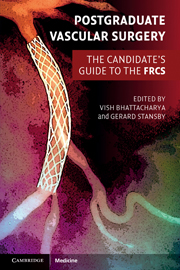Book contents
- Frontmatter
- Contents
- List of contributors
- Preface
- Section 1 Final FRCS vascular clinicals
- Section 2 Final FRCS vascular topics
- 1 Vascular risk factors and their management
- 2 Management of acute limb ischaemia
- 3 Chronic lower limb ischaemia, critical ischaemia and the diabetic foot
- 4 Endovascular and surgical options for peripheral revascularisation
- 5 Abdominal aortic aneurysms
- 6 Thoracic, thoracoabdominal and suprarenal aortic aneurysms
- 7 Aortic dissection
- 8 Popliteal artery aneurysms
- 9 Femoral artery aneurysms
- 10 Carotid, subclavian and vertebral disease
- 11 Diagnosis and management of thoracic outlet syndrome
- 12 Diagnosis and management of hyperhidrosis
- 13 Chronic mesenteric ischaemia
- 14 Acute ischaemic colitis
- 15 Vascular trauma
- 16 Indications and management of lower limb amputation
- 17 Leg swelling and lymphoedema
- 18 Varicose veins and chronic venous insufficiency
- 19 Management of deep vein thrombosis
- 20 Infection in vascular surgery
- 21 Vascular malformations
- 22 Vasospastic disorders and vasculitis
- 23 Critical care considerations and preoperative assessment for general and vascular surgery
- 24 Access surgery
- 25 Basic outline of solid organ transplantation
- Index
- References
15 - Vascular trauma
- Frontmatter
- Contents
- List of contributors
- Preface
- Section 1 Final FRCS vascular clinicals
- Section 2 Final FRCS vascular topics
- 1 Vascular risk factors and their management
- 2 Management of acute limb ischaemia
- 3 Chronic lower limb ischaemia, critical ischaemia and the diabetic foot
- 4 Endovascular and surgical options for peripheral revascularisation
- 5 Abdominal aortic aneurysms
- 6 Thoracic, thoracoabdominal and suprarenal aortic aneurysms
- 7 Aortic dissection
- 8 Popliteal artery aneurysms
- 9 Femoral artery aneurysms
- 10 Carotid, subclavian and vertebral disease
- 11 Diagnosis and management of thoracic outlet syndrome
- 12 Diagnosis and management of hyperhidrosis
- 13 Chronic mesenteric ischaemia
- 14 Acute ischaemic colitis
- 15 Vascular trauma
- 16 Indications and management of lower limb amputation
- 17 Leg swelling and lymphoedema
- 18 Varicose veins and chronic venous insufficiency
- 19 Management of deep vein thrombosis
- 20 Infection in vascular surgery
- 21 Vascular malformations
- 22 Vasospastic disorders and vasculitis
- 23 Critical care considerations and preoperative assessment for general and vascular surgery
- 24 Access surgery
- 25 Basic outline of solid organ transplantation
- Index
- References
Summary
Key points
Remember the whole patient, do not just focus on the vascular injury
Time is of the essence, avoid delay
Do not attempt to mobilise large veins, use local pressure
Consider temporary intravascular shunts in complex limb injuries
Consider damage limitation surgery in patients developing hypothermia or acidosis
Trauma is a leading cause of mortality in the first four decades of life. Vascular surgeons are often involved in the management of a multiply-injured patient who may have limb- and/or life-threatening vascular injuries. In addition the extended range of procedures carried out by open and minimally invasive surgical and radiological techniques has created its own unique set of vascular injuries. It is beyond the scope of this short chapter to deal with specific vascular injuries in detail, however, general principles will be discussed with specific details given in the more common sites of injury.
General considerations
Vascular trauma can occur as a result of a variety of mechanisms including penetrating, blunt, crush, irradiation and a variety of iatrogenic injuries. The majority of penetrating injuries in civilian life in the UK are caused by knives or low-velocity handguns. Penetrating injuries in military and terrorist theatres are more often associated with high-velocity weapons, bombs and missiles, the latter can cause extensive tissue damage due to a combination of blast and shrapnel injuries.
Blunt vascular trauma is usually seen following road traffic accidents, falls, building collapses, major disasters, etc.
- Type
- Chapter
- Information
- Postgraduate Vascular SurgeryThe Candidate's Guide to the FRCS, pp. 172 - 182Publisher: Cambridge University PressPrint publication year: 2011

